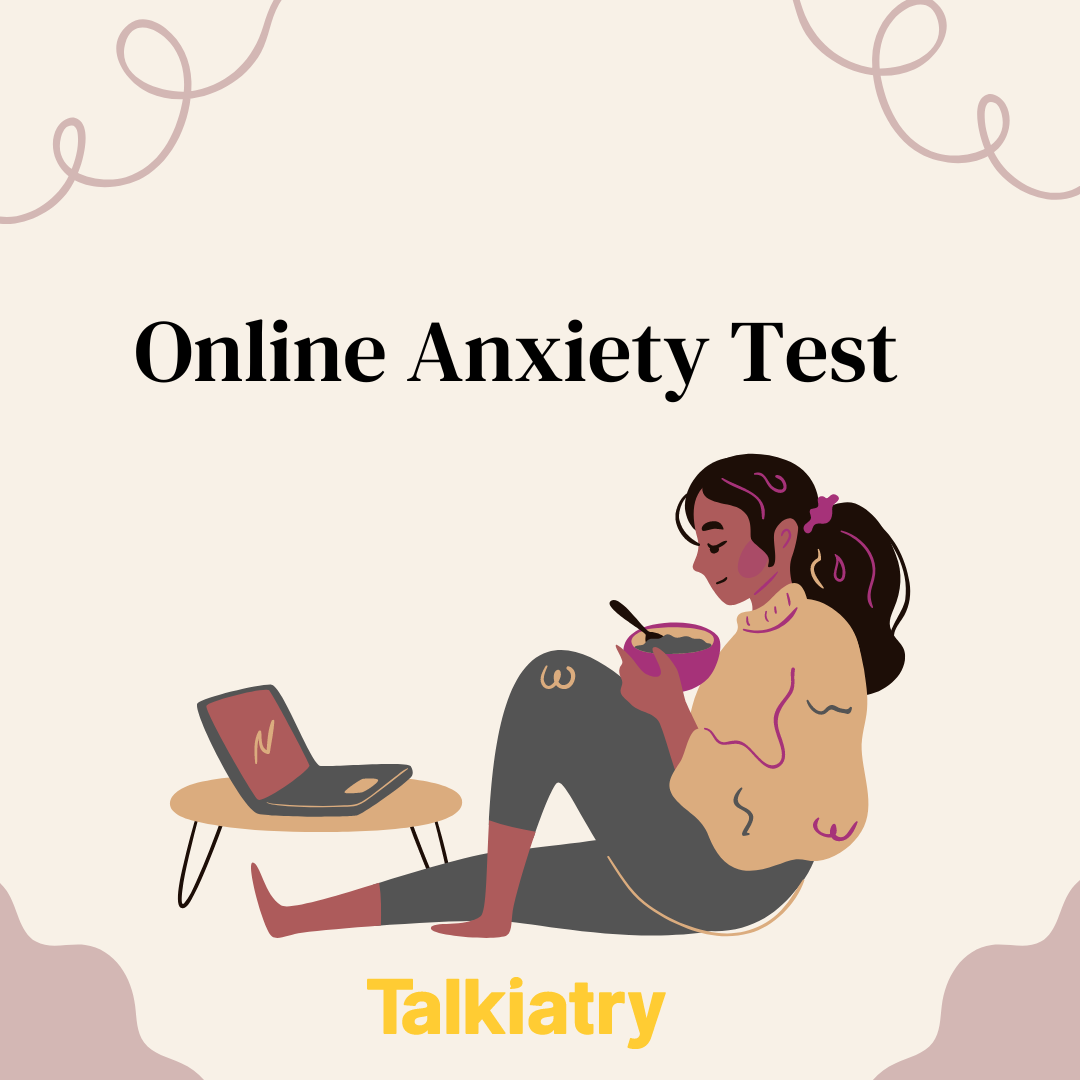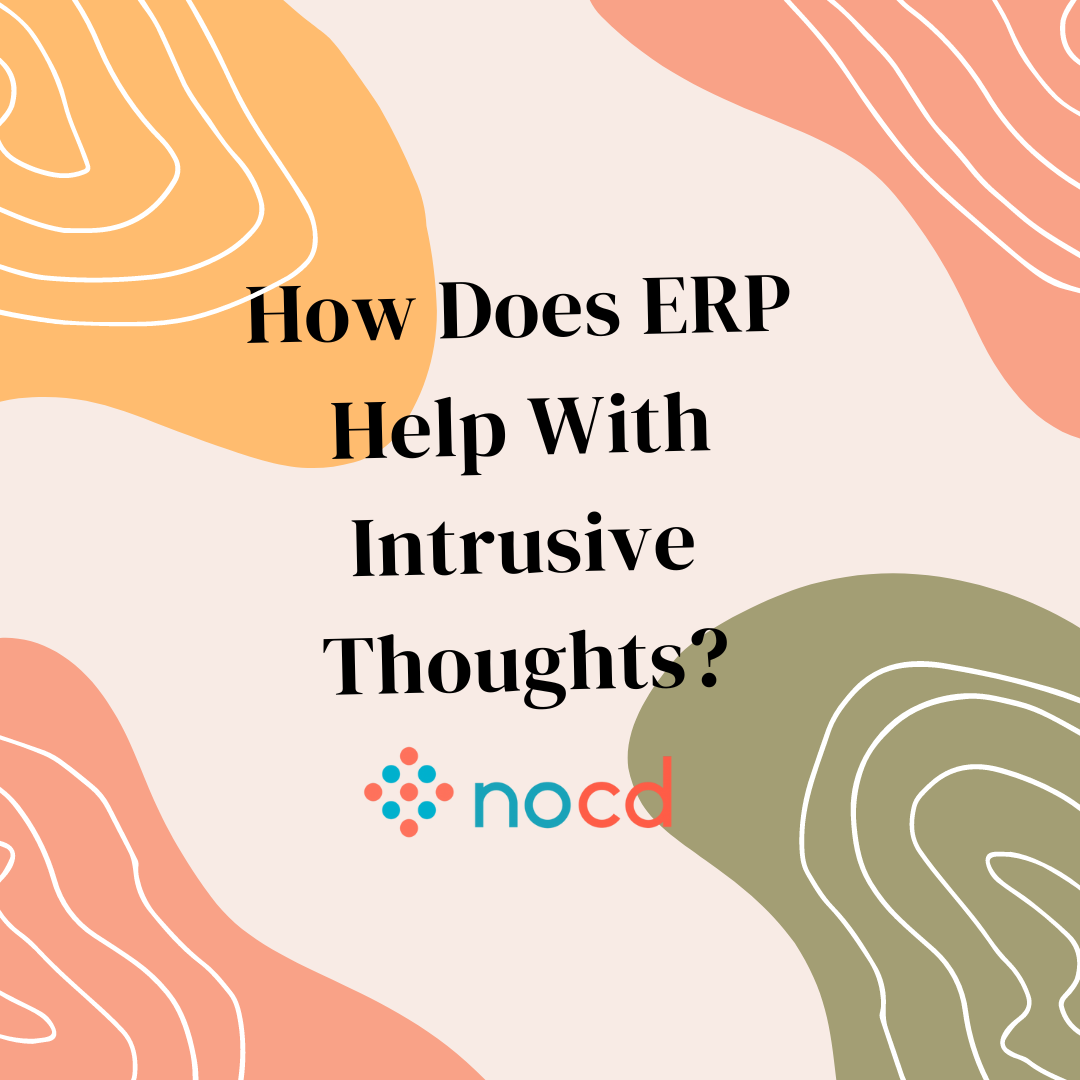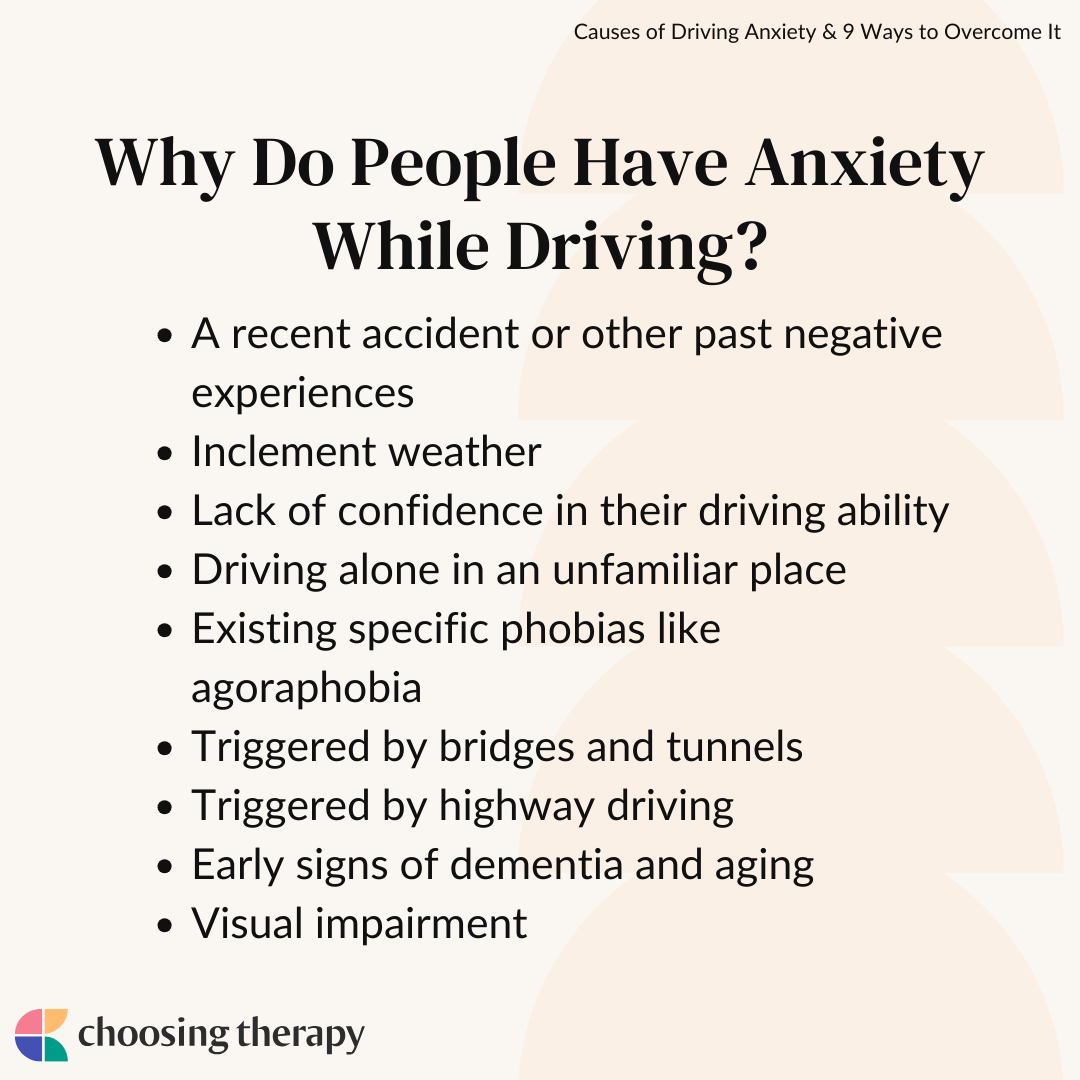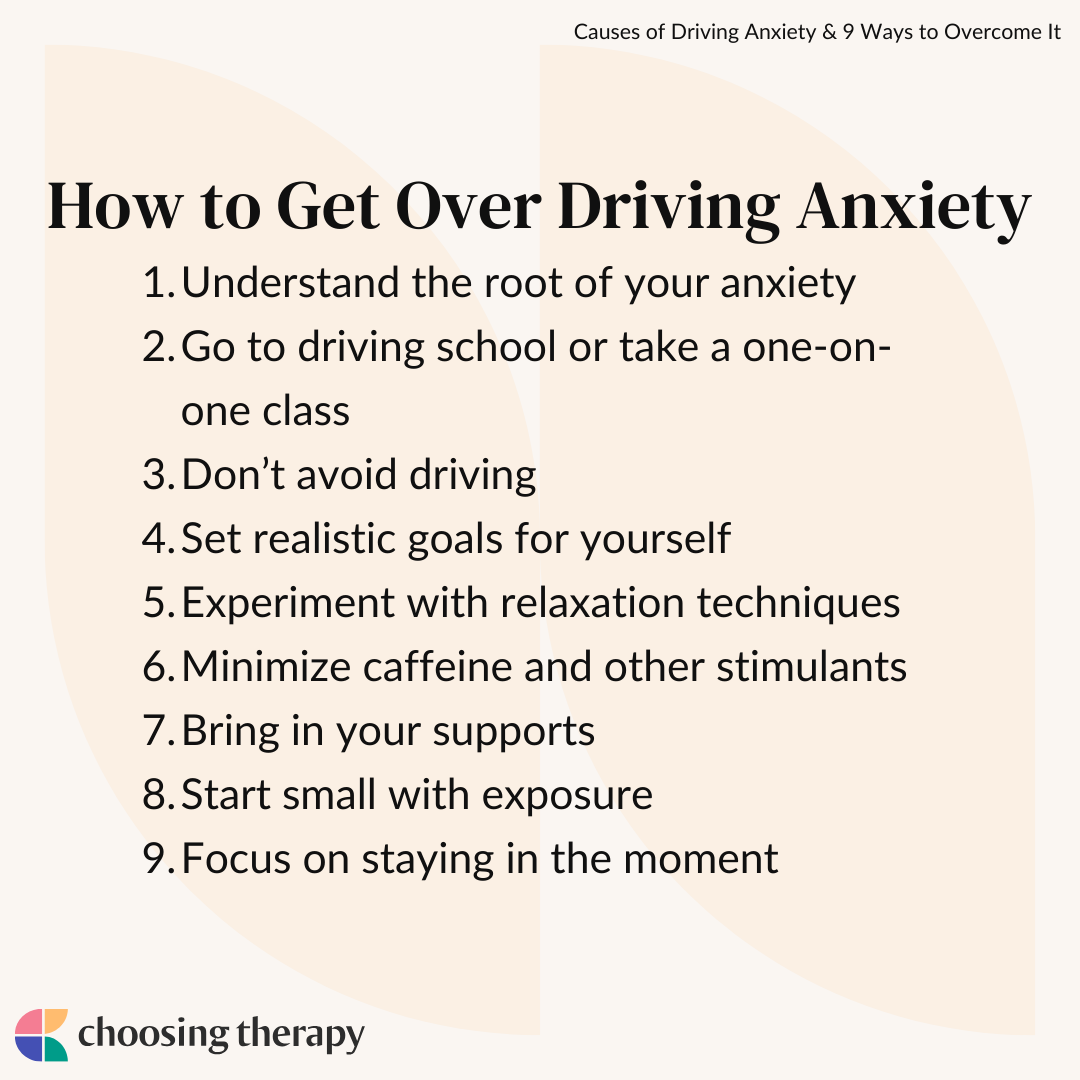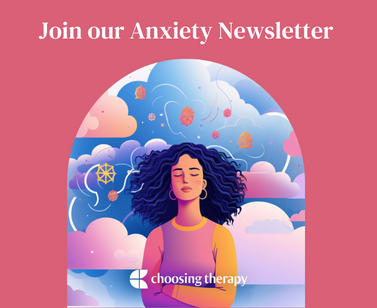It’s common for driving to trigger panic and anxiety in people. Just the thought of having to drive can make some people extremely anxious. For others, specific conditions may be particularly anxiety inducing, such as when a route involves crossing bridges or passing through tunnels.
Driving anxiety symptoms can range from mild discomfort to extreme distress. If the anxiety is left unaddressed, it can have significant impacts on people’s lives. For example, a panic attack while driving may cause a traffic accident, while avoidance of driving can leave people homebound and isolated.
There are many effective ways to reduce feelings of anxiety related to driving, including practical coping strategies and therapy. In fact, getting therapy for anxiety helps around 80% of people reduce driving anxiety symptoms.1
What Is Driving Anxiety?
While not an official diagnosis, driving anxiety refers to fearful thoughts or intense worry about driving. This can range from feeling a little nervous to having full panic attacks or even avoiding driving altogether. For some people, the anxiety is present any time they have to drive. For others, it depends on the situation, like driving a certain route or a specific car.
Would you like to have less anxiety?
Anxiety is treatable with therapy. BetterHelp has over 20,000 licensed therapists who provide convenient and affordable online therapy. BetterHelp starts at $65 per week. Take a Free Online Assessment and get matched with the right therapist for you.
Driving Anxiety Symptoms
Signs of driving anxiety can range from a subtle change in thinking when grabbing the keys, to a slow-building anxiety while driving on the freeway, to a full-blown anxiety attack at the mere thought of getting behind the wheel.
Symptoms of driving anxiety include:2
- Feeling restless, keyed up, or on edge when driving, preparing to drive, or thinking about driving
- Feeling easily fatigue and tired during or after a trip in the car
- Having trouble concentrating while behind the wheel
- Being irritable and short with others
- Feeling tension, especially in the neck and back while driving
- Having troubling or anxious dreams involving driving
These symptoms could present rapidly, or they could grow steadily over the course of many years. A person with a driving phobia (aka vehophobia, amaxophobia, and ochophobia) could have such an intense fear that they stop driving completely. This decision could cut them off from friends, family, and other positive aspects of life as they become confined to their home.
Causes of Driving Anxiety
Anxiety is thought to be caused by some combination of genetic vulnerability, stressful events, underlying medical conditions, and even certain medications. The causes of driving anxiety range from having been involved in an accident, experiencing stressful driving conditions, or living with a physical condition that makes driving more difficult.
Some underlying causes of driving anxiety include:3,4,5
Experiencing a Recent Accident
Perhaps the clearest cause of driving anxiety is when someone experiences a recent crash. The accident may trigger a number of reactions like post-traumatic stress disorder (PTSD), acute stress disorder, adjustment disorders, and phobias. It’s estimated that up to 30% of people experience anxiety related symptoms after being involved in a traffic accident.3
Driving in Inclement Weather
While inclement weather will increase the stress felt by most drivers, for some it triggers driving intense anxiety. Having to drive in adverse conditions like snow, ice, fog, heavy rains, or even low-visibility times of day may trigger anxiety in people.
Having a Lack of Confidence in Your Driving Ability
A person may develop anxiety if they don’t feel confident in their abilities. This can come up for new drivers or someone who may be driving in different conditions than they are used to. Loss of confidence can also occur after an accident, causing someone to doubt themselves, fear it happening again, or not trust other drivers.
Driving Alone in an Unfamiliar Place
Driving alone in an unfamiliar place can trigger anxiety by causing a person to feel uncertain or unsure of what to do. They may not feel safe, worry about taking a wrong turn, or fear getting lost or being late.
Having an Existing Phobia
Those with existing phobias, especially phobias related to open spaces or crowds (like agoraphobia), may increase the risk of driving anxiety.
Stress of Driving on Bridges & Tunnels
Bridges and tunnels have the ability to tap into a fearful response from people, even when they don’t have specific phobias. Tunnels can lead to people feeling closed in and trapped, while bridges can create images of collapses or driving over the side.
Stress of Highway Driving
Highway driving involves faster speeds, more cars, more lanes of traffic, more distractions, and more danger. People who are not used to this experience may feel overwhelmed and overstimulated by the action on the expressway which may trigger driving anxiety.
Experiencing Signs of Dementia & Old Age
As people age, their reaction times slow and their physical responses are not as sharp as they once were, which can result in increased stress and pressure. Additionally, as cognitive decline and early signs of dementia present, panic attacks could be more likely.
Having a Family History of Anxiety Disorders
Some studies have shown that anxiety may be genetic, so having a family history of anxiety disorders greatly increases a person’s chance of developing anxiety. Driving-related anxiety is just one way this could be expressed.
Having a Visual Impairment
For some, driving anxiety will be the result of impaired vision. If your driving anxiety is accompanied by dizziness, light-headedness, or a loss of balance, it would be a good idea to contact an optometrist and schedule an eye exam.
Options For Anxiety Treatment
Talk Therapy – Get help from a licensed therapist. Betterhelp offers online therapy starting at $65 per week. Free Assessment
Psychiatry for Anxiety – Looking for anxiety treatment that prioritizes you? Talkiatry can help. Find an in-network psychiatrist you can see online. Get started with our short assessment. Visit Talkiatry
Impacts of Driving Anxiety
Driving anxiety can negatively impact a person’s physical and mental health in the short-term through muscle tension and irritability. It can also have long-term impacts as the person may develop a strong enough fear to skip driving altogether and miss important appointments.
Some potential effects of living with driving anxiety include:2
- Chronic muscle tension
- Restlessness or fatigue
- Changes in heart rate and stress levels
- Higher risk of having an accident if driving causes panic attacks
- Likelihood of reduced mobility as someone becomes more anxious about driving
- Problems related to finances, housing, relationships, and employment if someone stops driving due to anxiety
How to Get Over Driving Anxiety
Anxiety related to driving a car can be a very powerful force in a person’s life, but luckily, there are many ways to cope with driving related anxiety. By taking steps to understand your anxiety, explore strategies that help minimize symptoms, and implement behavioral interventions, you can take steps to overcome your anxiety.
Here are nine practical tips to overcome driving anxiety:6
1. Understand the Root of Your Anxiety
Understanding the root causes associated with your driving anxiety can help you develop the appropriate coping skills to minimize symptoms. Take a moment to retrace your experiences with driving anxiety by investigating when it began, when it worsened, and what people, places, and things are involved in the process.
Did your parents exhibit signs of driving anxiety as well, or did a recent accident trigger these symptoms? Does the anxiety strike all of the time or only when you drive alone?
Perhaps the most important aspect of this is to understand if driving anxiety is the main problem or a symptom of a larger problem. If the driving issues are linked to PTSD, obsessive-compulsive disorder (OCD), or another serious anxiety disorder, professional treatment will be needed to target these larger issues.
2. Go to Driving School or Take a One-on-One Class
Some driving schools offer refresher or advanced driving courses. Consider taking a driving class to increase your skills and comfort level behind the wheel, including dealing with stressful situations like inclement weather.
3. Don’t Become Avoidant of Driving
Avoiding situations very rarely works in the long term. A person may feel relief at first when utilizing avoidance coping, but when it comes up again the fear is still there. This creates a never ending cycle of fear and avoidance. The best way through is to face the fear while using coping skills to tolerate the anxiety.
4. Set Realistic Goals for Yourself
During this process, you will need to be intentional with the goal you hope to achieve and how you hope to achieve it. Consider the long-term and short-term consequences of your actions.
If your goal is to achieve long-term relief of anxiety while driving, you will likely pursue a certain path. If your goal is to only escape anxiety in the short-term, another set of choices will accomplish that result. Ultimately the decision is yours, but be sure to remember that what’s best for the short-term isn’t usually best in the long-term.
5. Experiment With Relaxation Techniques
Whenever high stress and anxiety begin to spring forth in new situations, it is a wonderful time to reevaluate your relaxation techniques. Relaxation techniques are behavioral interventions that help minimize stress and anxiety.
The following are relaxation techniques that are used to reduce anxiety:
- Deep breathing: Intentionally controlling your breath, reducing stress and increasing a sense of calm.
- Progressive muscle relaxation (PMR): The process of tensing then relaxing one group of muscles at a time.
- Guided imagery: Using your imagination to create calm and peaceful images, promoting relaxation.
- Mindfulness meditations: Focused awareness, attention turned purposefully to something in your present moment.
- Autogenic training: This type of relaxation technique replaces the worry and fear of anxiety with calm and uplifting self-talk.
Find a supportive therapist who can help with anxiety.
BetterHelp has over 20,000 licensed therapists who provide convenient and affordable online therapy. BetterHelp starts at $65 per week. Take a Free Online Assessment and get matched with the right therapist for you.
6. Minimize Caffeine & Other Stimulants
Research shows there is a a connection between caffeine and anxiety. In addition to caffeine, other stimulants like nicotine and certain over-the-counter and prescription medications increase heart rate, blood pressure, and alertness, leading to an increase in anxiety symptoms. Taking these medications before driving can make driving anxiety worse.
7. Bring In Your Supports
You probably could confront and improve your driving-related anxiety independently, but tackling a tricky issue with your friends and family is always more rewarding and more fun. If you need help with your driving anxiety, bring in your support system.
When dealing with driving anxiety, supports can help by:
- Reminding you of coping skills
- Recommending new coping skills
- Keeping you on track
- Driving with you to reduce tension and stress
Even the process of sharing your story of driving anxiety can be helpful. Telling others about your stress and struggles can help the healing process and speed your recovery.
8. Start Small With Exposure
Even though you may be tempted to take bold steps to resolve your driving anxiety, stressful situations require time and patience to resolve. Avoid putting yourself in a position where you are not likely to succeed.
To reduce driving anxiety, spend time thinking about the aspects of driving that trigger anxiety. Ask yourself:
- When does the anxiety start?
- What makes the anxiety peak?
- When do the anxiety symptoms decrease
- What does the anxiety feel like?
By identifying and targeting the facets of driving that cause mild anxiety and repeating them regularly while using relaxation skills, your body will begin to adjust to the physical and mental sensations of anxiety, and the situation won’t feel as stressful.
By exposing yourself to more and more stressful aspects of driving anxiety, you will cause a temporary increase in anxiety but a long-term decrease. Without this exposure, your symptoms cannot improve.
Be cautious, trying to move too quickly can actually increase driving-related anxiety.
9. Focus on Staying in the Moment
Mindfulness is the practice of being present in the moment, without judgment. For driving, this could include noticing anxiety sensations in the body in a neutral way, like, “I notice tightness in my chest.” This could also include tuning into the senses, for instance, noticing the color of the sky, the feel of the steering wheel, and the song on the radio.
Driving Anxiety Treatment
For some people, driving-related anxiety is a condition they can resolve on their own. Others, though, will need the guidance and knowledge of a mental health professional. Mental health therapists can fully assess your symptoms and prescribe a course of treatment specifically tailored to your needs. You can use a therapist directory to find an anxiety specialist to work with, request a referral from a trusted medical professional, or utilize one of the many online therapy options available today.
Therapy for Driving Anxiety
Once physical and neurological reasons for increased anxiety have been ruled out by a medical professional, the most effective treatment options for driving anxiety are cognitive behavioral therapy, exposure therapy, and the principles of systematic desensitization.5 In fact, some elements of exposure therapy and systematic desensitization can be conducted using virtual reality techniques to simulate a real-life experience.3
Medication for Driving Anxiety
In addition to psychotherapy options, your physician or psychiatrist may also discuss anxiety medication options with you, with the goal of reducing the frequency and severity of anxiety symptoms. The first medications considered are typically an SSRI, SNRI, or
Approximately 80% of those with untreated anxiety conditions, like driving anxiety, will go on to develop a chronic mental health issue—this is just another reason why it’s crucial to get professional help if you’re dealing with any type of anxiety.1
Driving Anxiety vs Having a Panic Attack While Driving
While anxiety about driving can go up and down in intensity, the anxiety is typically always lingering in the background. But panic attacks while driving involve very sudden, intense surges of fear, anxiety, and discomfort with clear beginnings and clear end points. Their sudden onset can overwhelm a person’s thoughts, feelings, and behaviors.
Signs of a panic attack while driving may include:2
- Heart palpitations
- Excessive sweating
- Feeling shaky
- Shortness of breath or trouble breathing
- Chest pain and tightness
- Nausea or stomach discomfort
- Feeling dizzy or lightheaded
- Having chills or feeling very hot
- Numb or tingling sensations
- Feeling disconnected from the body
- Fear of losing control or “going crazy”
- Fear of dying
Safely Coping with a Panic Attack While Driving
Panic attacks are always troubling. Experiencing one while driving can not only be uncomfortable, but it can be dangerous as well.
Dealing with a panic attack while driving will take intentional, quick action. At the first sign of a panic attack, someone should:
- Acknowledge the physical and mental sensations related to a panic attack
- Let others in the car know what to do and how to respond
- Pull over immediately but safely
- Put on hazard lights to alert other drivers
- Stay in the car to avoid traffic
- Practice and employ healthy coping skills until the panic attack passes
The first time a person has a panic attack while driving, the situation will create tremendous fear and uncertainty. As they gain experience, though, they will discover a helpful process for effectively reducing symptoms and keeping themselves safe.
In My Experience
Additional Resources
To help our readers take the next step in their mental health journey, Choosing Therapy has partnered with leaders in mental health and wellness. Choosing Therapy is compensated for marketing by the companies included below.
Talk Therapy
Online-Therapy.com – Get support and guidance from a licensed therapist. Online-Therapy.com provides 45 minutes weekly video sessions and unlimited text messaging with your therapist for only $64/week. Get Started
Virtual Psychiatry
Hims / Hers If you’re living with anxiety or depression, finding the right medication match may make all the difference. Connect with a licensed healthcare provider in just 12 – 48 hours. Explore FDA-approved treatment options and get free shipping, if prescribed. No insurance required. Get Started
Anxiety Newsletter
A free newsletter from Choosing Therapy for those impacted by anxiety. Get helpful tips and the latest information. Sign Up
Learn Mindfulness, Meditation, & Relaxation Techniques
Mindfulness.com – Change your life by practicing mindfulness. In a few minutes a day, you can start developing mindfulness and meditation skills. Free Trial
Choosing Therapy Directory
You can search for therapists by specialty, experience, insurance, or price, and location. Find a therapist today.
Online Anxiety Test A few questions from Talkiatry can help you understand your symptoms and give you a recommendation for what to do next. How Does ERP Help With Intrusive Thoughts? Obsessive compulsive disorder (OCD) is a psychiatric condition marked by the presence of obsessive thoughts, images, doubts, or urges, followed by compulsive behaviors or acts aimed at easing the distress caused by the obsession. While the content of the obsessions can take many forms, they are always repetitive, persistent, involuntary, and intrusive, and they often result in a great deal of anxiety for the person experiencing them.